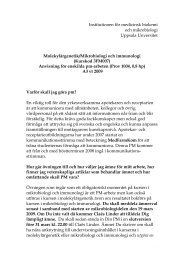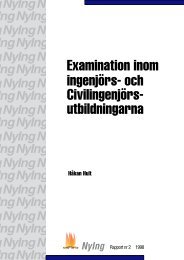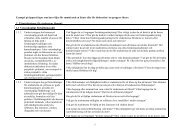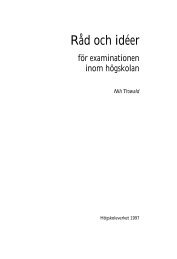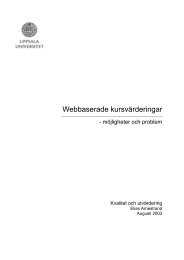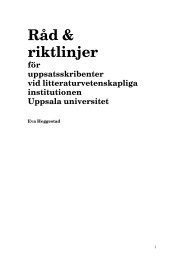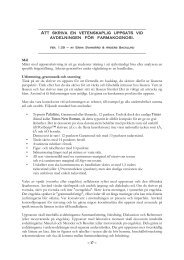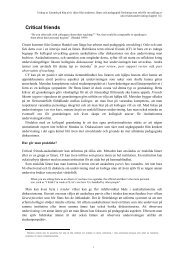Aligning teaching and assessment to curriculum objectives John Biggs
Aligning teaching and assessment to curriculum objectives John Biggs
Aligning teaching and assessment to curriculum objectives John Biggs
Create successful ePaper yourself
Turn your PDF publications into a flip-book with our unique Google optimized e-Paper software.
As there is no intrinsic connectionbetween the <strong>curriculum</strong> <strong>and</strong><strong>assessment</strong>, just focus on what will getyou through the <strong>assessment</strong>.For a further treatment of this controversial<strong>to</strong>pic see <strong>Biggs</strong> (2003, Chapters 8, 9).So what’s the alternative?The alternative is an <strong>assessment</strong> system thattells you how well each individual student’sassessed performances match what is required.Surely this is the aim of all <strong>teaching</strong>. Itrequires teachers <strong>to</strong> state desired outcomes inthe form of st<strong>and</strong>ards or criteria thatstudents are <strong>to</strong> attain. How well they attainthem, minimally or beyond reasonableexpectations, is reflected in the gradingsystem. Most students should be able <strong>to</strong> reachthem at an ‘acceptable’ level.Matching individual performances against thecriteria is not a matter of counting marks bu<strong>to</strong>f making holistic judgments. And this is whereteachers start <strong>to</strong> worry. Judgment is‘subjective’, isn’t it?, while quantitative markingis precise <strong>and</strong> objective. In case of dispute youcan point <strong>to</strong> a number, a score: You didn’t getenough marks, sorry. Isn’t that much easierthan justifying a holistic judgment?No. Those ‘marks’ are themselves anaccumulation of mini-subjective judgments. Theresidual error is probably greater than that inan holistic judgment that can be justified byargument <strong>and</strong> reference <strong>to</strong> the criteria.Rather, I would ask you <strong>to</strong> justify why 75 <strong>and</strong>over should be an A. Why not 70? Or 90? It isalmost universally accepted that getting halfright, 50 per cent, should be a pass. Why?Numbers, <strong>and</strong> arbitrary cutting points, onlyappear <strong>to</strong> make the process objective <strong>and</strong>precise. It is not at all.So we come back <strong>to</strong> holistic judgment.Teachers should be able <strong>to</strong> justify theirjudgments. And this is so much easier if thecriteria <strong>to</strong> be met are spelled out in the initial<strong>objectives</strong>. Dealing with student disputes thenbecomes a seminar on the nature of goodlearning, not a demeaning quibble over a markhere, a mark there.An example: Arriving at a final gradeLet us look at an example of qualitative grading.The following were the grading criteria I usedin a unit in a Master’s programme foreducational psychologists.CURRICULUM AND INSTRUCTIONCourse Objectives <strong>and</strong> Grade CriteriaGrading will be based on your attaining the following<strong>objectives</strong>:1. demonstrate that you correctly underst<strong>and</strong> <strong>and</strong>can apply the principles of good <strong>teaching</strong> <strong>and</strong><strong>assessment</strong> <strong>to</strong> chosen contexts.2. demonstrate a knowledge of selected aspects of<strong>curriculum</strong> design <strong>and</strong> management <strong>and</strong> how theyrelate <strong>to</strong> the educational system in Hong Kong.3. show how the content <strong>and</strong> experiences in thiscourse may enhance your effectiveness as an EP.4. show evidence of reflective decision-makingFinal grades will depend on how well you c<strong>and</strong>emonstrate that you have met all <strong>objectives</strong>:A: awarded if you have clearly met all the<strong>objectives</strong>, displaying deep knowledge of thebase content, original <strong>and</strong> creative thinking,perhaps going beyond established practice.B: awarded when all <strong>objectives</strong> have been met verywell <strong>and</strong> effectively.C: awarded when the <strong>objectives</strong> have beenaddressed satisfac<strong>to</strong>rily, or where the evidenceis strong for some <strong>objectives</strong>, weaker butacceptable in others.F: less than C, work plagiarised or not submitted.



